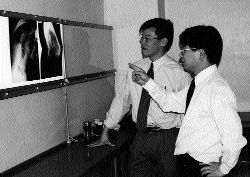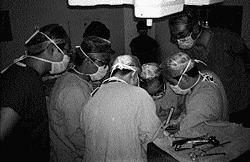|
Hu-Ping Hsu and
Myron Spector serve as representatives of Harvard Orthopaedics in the
BSB and Harvard Medical International is represented by Mitchell W. Spellman,
M.D., Ph.D., Professor of Surgery, Emeritus, Harvard Medical School, a
Director of HMI, and Arnold Longboy, M.S., Director of Educational Programs,
HMI.
Recognizing
that international medical programs at Harvard would be of growing importance,
in 1994, Dean Daniel Tosteson established Harvard Medical International
to review opportunities for international programs and facilitate their
development. The goal of HMI is that patients should not have to leave
their region to receive the highest level of medical care
| The
Mission of the BSB: |
| • |
To advance education and training programs in
orthopedic surgery in China. |
| • |
To facilitate the exchange of students,
fellows, and faculty among the participating institutions. |
| • |
To facilitate the exchange of ideas and advice
regarding laboratory and clinical research and assist in the
development of research facilities at the Chinese hospitals.
|
|
In
September of 1997 the BSB organized its first symposium in Beijing
at the Peking Union Medical College Hospital with Drs. G-X. Qiu
and C.B. Sledge serving as co-chairs. The topic was total joint
replacement, and approximately 100 surgeons from throughout China
were in attendance. Six faculty from Harvard Orthopaedics (C.B.
Sledge, T.S. Thornhill. F.C. Ewald, D.T. Reilly, H-P. Hsu, and M.
Spector), J. McCarthy from the New England Baptist Hospital, and
a few Chinese surgeons addressed several aspects of total joint
arthroplasty and other topics. At the close of the meeting participants
were presented with a certificate from Harvard Medical International.
|
The second
BSB Symposium was convened in Shanghai in March of 1999 and was hosted
by the Ninth People's Hospital of the Second Medical University of Shanghai,
with Drs. K. Dai and J.H. Herndon the co-chairs. The topics included trauma
and spine surgery and selected issues in sports medicine. Related presentations
dealt with tissue engineering and gene therapy. The attendees included
over 150 orthopaedic surgeons. The faculty comprised nine members from
Harvard Orthopaedics (J.H. Herndon, J.B. Emans, S.D. Martin, R.M. Ozuna,
F. Pedlow, J.E. Ready, J. R. Wright, H-P. Hsu, and M. Spector) and 11
Chinese orthopaedic surgeons. The American contingent was joined by Walt
LeClair, M.D. from the University of Massachusetts Medical Center and
Mitchell Dube, M.D. from the Lahey Clinic.
The third
BSB Symposium is being planned for the fall of 2000 in Beijing with the
Ji Shui Tan Hospital of Beijing Medial University the host. Topics will
include sports medicine, tumors, upper extremities, osteotomy, and revision
arthroplasty. All of the symposia offer simultaneous translation. It is
interesting to note, however, that most of the younger surgeons and many
of the senior surgeons understand and speak English well enough to participate
in the meeting without translation.
The educational
and training programs for orthopaedic surgeons in China have many similarities
with those in the US. Understandably, there are, however, only limited
opportunities for residents and attending surgeons to participate in meetings
outside of China where they would have an opportunity to learn of new
techniques and results of long term follow-up of procedures and implants.
Moreover, there is not widespread availability of current issues of international
orthopaedic journals. These limitations notwithstanding, Chinese surgeons
are remarkably up-to-date with respect to their awareness of the current
state of orthopaedic surgery in the West. This is a reflection of their
desire to meet the standards of care set by the international orthopaedic
community. In part, the BSB symposia were conceived to address the lack
of opportunity of Chinese surgeons to interact with American orthopaedists,
by bringing the experts to China to teach the teachers.
The collaborative
tie between Harvard Orthopaedics and orthopaedic programs in China has
also facilitated the placement of our students in externships there. One
of the new Harvard Orthopaedics residents, Conrad Wang, spent a month
at the Peking Union Medical College Hospital in the spring of 1998. During
that time Dr. Wang had the opportunity to witness the approaches taken
to the care of a wide range of orthopaedic patients and contrast patient
management with that in the West. As an MIT graduate, Dr. Wang was eligible
for funding from The MIT International Science and Technology Initiative.
With an increase in the number of such exchanges of students, and faculty,
should come the kind of understanding and friendship that will assure
the longevity and productivity of the Harvard-China connection.
The quality
of orthopaedic care in China is high. This despite the limited availability
of advanced imaging equipment and surgical devices that might not be of
current design or highest quality with respect to materials composition,
machining tolerances, and finishing. The orthopaedists demonstrate great
surgical skill and their resourcefulness often makes up for any lack of
modern equipment, instruments, and implants. Interestingly, one of the
greatest differences between orthopaedic care in China and the United
States is the length of hospital stay. A joint replacement patient may
be admitted to the hospital one month prior to surgery and still be found
as an inpatient up to three months postoperatively. This is not due to
the orders of the surgeon but rather one of the privileges of the current
health care system that is sure to undergo change.
The level
of interest of Chinese orthopaedic surgeons in laboratory research is
notably high. This is, in part, related to the fact that many orthopaedic
residency programs confer a Ph.D. degree. While the course requirements
and depth of thesis research may not be directly comparable with doctoral
programs in the US, the dedication of the academic orthopaedic community
to laboratory as well as clinical investigation is clear. The integration
of laboratory research into the orthopaedic residency program is reflected
in the attitudes of many residents who have approached us for comments
on their investigative work including tissue engineering and gene therapy
projects as advanced as any being pursued in the US.
Of course,
one of the most gratifying aspects of an international collaboration is
the opportunity it provides to get to know colleagues in other countries
and to obtain insights into their culture. For example, tea is an important
ingredient of the Chinese culture, and during one trip we (H-P H and MS)
visited the premier green tea growing region of China - Dragon Wells -
in the lush hills bordering the city of Hangzhou, a 3-hour train ride
west of Shanghai. Our host was Dr. Xiang-Jiang Lin, Vice Chairman of the
Department of Orthopaedic Surgery at the First Affiliated Hospital in
Hangzhou. In a small hillside village, we were taken into a room in the
home of one of the growers to sample the tea prior to purchase. We were
unprepared for the large number of samples set before us - more than ten
types of green tea from which to choose. As we sat there rather bewildered,
Dr. Lin proceeded in systematic fashion to examine, smell, and lightly
touch the mounds of tea set before us. He requested that a few leaves
of one sample be brewed in a glass with water heated to just under boiling.
He then assessed the aroma and tasted the tea which displayed only the
faintest hint of a green color. As Dr. Lin explained the process of evaluating
the quality of a tea, one could not help but be struck by his connoisseurship
and the parallels with the evaluation of a good wine, single malt scotch,
or coffee. But as we complimented Dr. Lin on his expertise, we learned
that his knowledge was not obtained entirely voluntarily. During the cultural
revolution he, along with most academic physicians and others in learned
professions, was sent to the countryside to work for at least four years.
Dr. Lin spent much of his time toiling in the tea fields. He was one of
the lucky ones, to survive the times and get the opportunity to start
a new life. Perhaps this helps to explain the general desire of most of
the people who we have met, to look ahead. Absent the luxury of fond memories
of the past, the emphasis is on the promise of the future.
|


